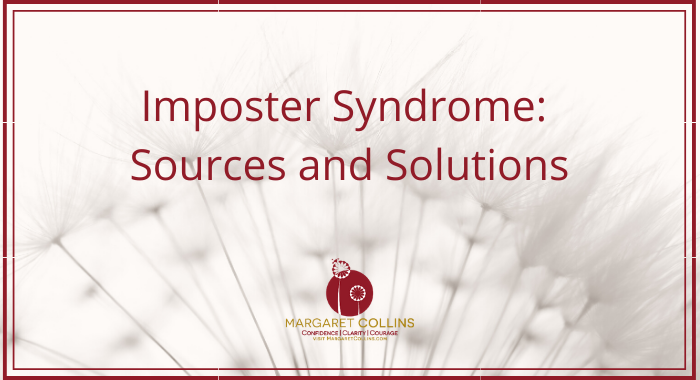Imposter Syndrome Sources and Solutions

Imposter Syndrome:
- Not believing my achievements are due to my ability
- A persistent fear of “being found out”
- Struggling to believe I’m good enough at what I do.
These feelings are surprisingly common, amongst both women and men, amongst people who are measurably and objectively good at what they do.
They cause unnecessary stress and anxiety and we can learn to manage them effectively.
This programme will help us to understand the nature and sources of our Imposter Syndrome feelings, to understand the consequences they have in our personal and professional lives and give you the tools you need to change.
PLEASE, do not share the links or these resources.
Do download the pdf companion workbook for each module and use it for reflective writing activities as you watch the videos in order. Doing the work as an active participant will allow you to make the changes you need, (top tip: playing the video in the background while you answer emails is not a helpful learning strategy!)
The modules below are organised as I might deliver them in a live workshop. Each has a companion workbook – a pdf file you can download – see the icon/image under the video.
Each video is about an hours worth of recorded content, designed to be worked through slowly, one module a week is plenty, giving you time to reflect on the learning and put some of the new ideas into practice as you progress.
Module 1
Module 1
Two things to do in this module:
- Watch the video (click on the CC button for captions)
- Download the workbook for Module 1 below the video
Do set aside time to watch module 1 video during the week. It lasts about an hour but you can watch it in segments.
At various points I have put in prompts for you to pause the video, reflect on what you’ve heard and write in your journal and/or the downloadable work book (see the link).
If you want to watch in chunks, or re-watch a section, use the table of contents below.
Hover your mouse over the bottom right hand corner of the video and next to the the settings “cog” is a menu icon. When you click on the icon you’ll get a menu of these “chapters” to make it easy to jump to a section. If you are watching on a desktop, they are also marked with a dot on the timeline.
- Introduction
- Overview
- Some helpful ground rules
- What is imposter syndrome?
- Well-known imposters
- Who is affected?
- Being or feeling different
- Reflection – your story
- Unconscious bias – what it is and why it matters
- Published examples
- Reflection – Unconscious bias
- Life map – what can you learn from the events of your life?
- Summary of Module 1
- Supplementary – My Story – from Imposter to Empowered!
As you complete a module I really recommend you take some time to reflect on your progress in some form of journaling activity during the week. Please do share your thoughts, insights and questions.
Bring everything to the live Q&A/group coaching Zoom call (details will be in an email).
If you have any questions do contact me.
Module 2
Module 2
Two things to do on this page:
- Watch the video
- Download the companion workbook for Module 2
Do set aside time to watch module 2 video during the week. It lasts about an hour but you can watch it in segments.
At various points I have put in prompts for you to pause the video, reflect on what you’ve heard and write in your journal and/or the downloadable work book (see the link below).
If you want to watch in chunks, or re-watch a section, here is a table of contents of the video. Hover your mouse over the bottom right hand corner of the video and next to the the settings “cog” is a menu icon. When you click on the icon you’ll get a menu of these “chapters” to make it easy to jump to a section. If you are watching on a desktop, they are also marked with a dot on the timeline.
- Introduction and Recap of Module 1
- The consequences of Imposter Syndrome and why it matters
- Equality in Leadership
- Invisible Women
- Equality in Society
- Reflection – Why is Imposter Syndrome important
- Imposter Syndrome and stress
- Imposter Syndrome and belonging
- Reflection – where do you feel you belong?
- Wholehearted living
- Reflection – where do you feel you fit in?
- Imposters and Competence
- Reflection – Imposters and Competence
- Do you want to leave Imposter feelings behind?
- Supplementary video
Module 3
Module 3
Two things to do in this module:
- Watch the video
- Download the companion workbook for Module 3
Do set aside time to watch module 3 video during the week. It lasts about an hour but you can watch it in segments.
At various points I have put in prompts for you to pause the video, reflect on what you’ve heard and write in your journal and/or the downloadable work book (see the link below).
If you want to watch in chunks, or re-watch a section, here is a table of contents of the video.
Hover your mouse over the bottom right hand corner of the video and next to the the settings “cog” is a menu icon. When you click on the icon you’ll get a menu of these “chapters” to make it easy to jump to a section. If you are watching on a desktop, they are also marked with a dot on the timeline.
- Introduction and Recap of Modules 1 & 2
- Imposters think differently
- Imposters and success
- Time to reflect on Imposters and success
- Imposters and failure
- Time to reflect on Imposters and success
- Imposters and competence
- Keeping safe
- What if…?
- How do you feel when you think about shining?
- What if you chose to be brave?
- Reflection – Imposters keeping their Inner Selves safe
- Imposters and their Inner Critic
- What values do your self-critical messages highlight for you?
- Reflection – Imposters and their Inner Critic
- Choosing more helpful thoughts
- Summary and supplement
Module 4
Module 4
Two things to do in this module:
- Watch the video
- Download the companion workbook for Module 4
Do set aside time to watch module 4 video during the week. It lasts about an hour but you can watch it in segments.
At various points I have put in prompts for you to pause the video, reflect on what you’ve heard and write in your journal and/or the downloadable workbook (see the link below).
If you want to watch in chunks, or re-watch a section, here is a timeline of the video:
- Recap of Module 3
- Neuroplasticity
- Ways we create results
- Tool 1: Re-write your story
- Tool 2: Own your achievements
- Tool 3: Recognise your Imposter
- Tool 3a – Recognise our imposter and be ready
- Tool 3b – Deep breathing
- Reflection – What are you implementation intentions?
- Tool 4: Redefine success and failure
- Tool 4a Values
- Tool 5: Learn to master your focus
- Tool 5a – Focus on self-acceptance
- Tool 5b – Focus on what you want, not on what you fear
- Tool 6: Choose more helpful habits
- Reflection – What beliefs would help you be your best self?
- On courage
- What could you do? What will you do?
- Expect some Resistance
- What next?
- What about the Gremins?
- Be you best self

